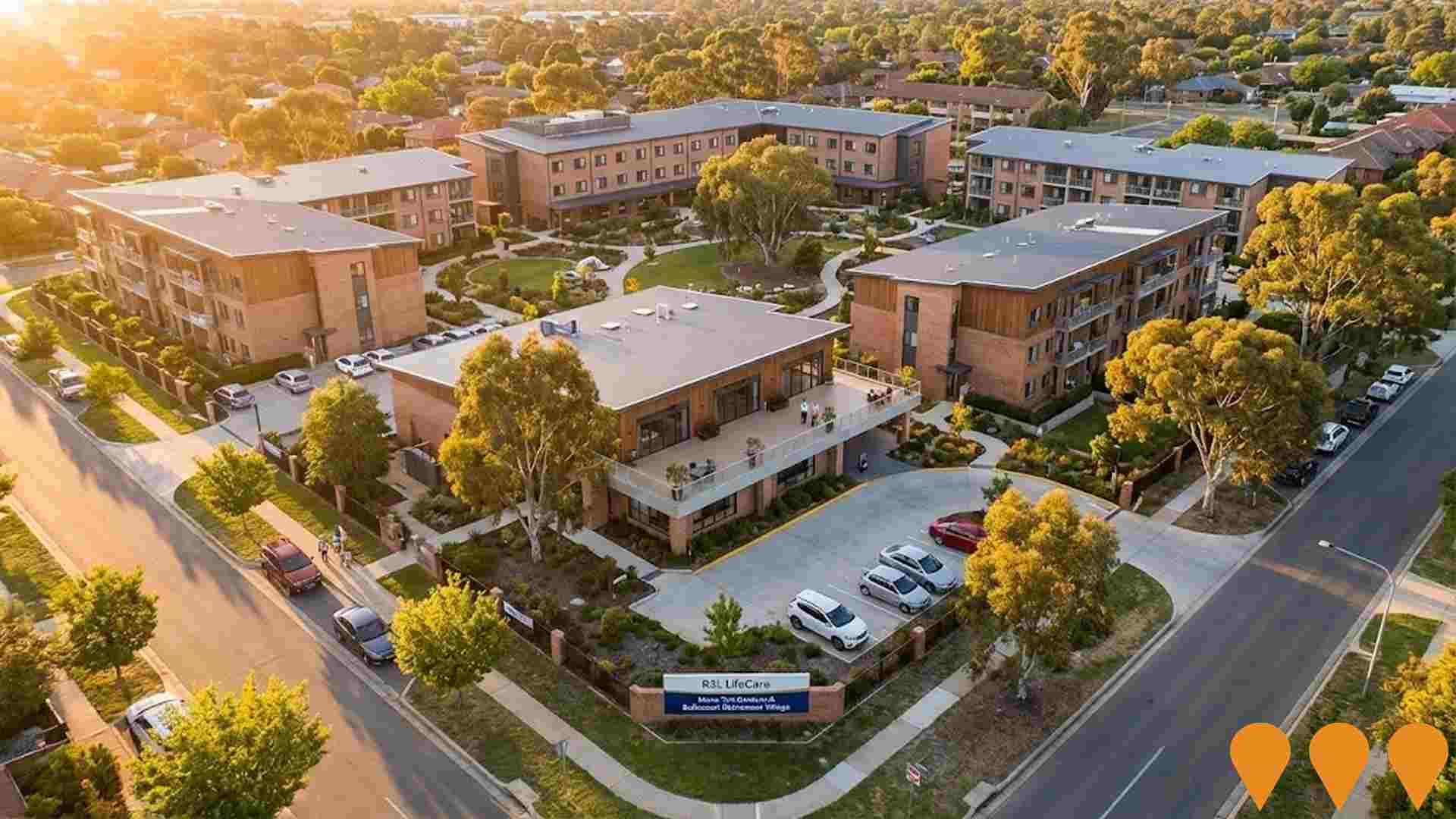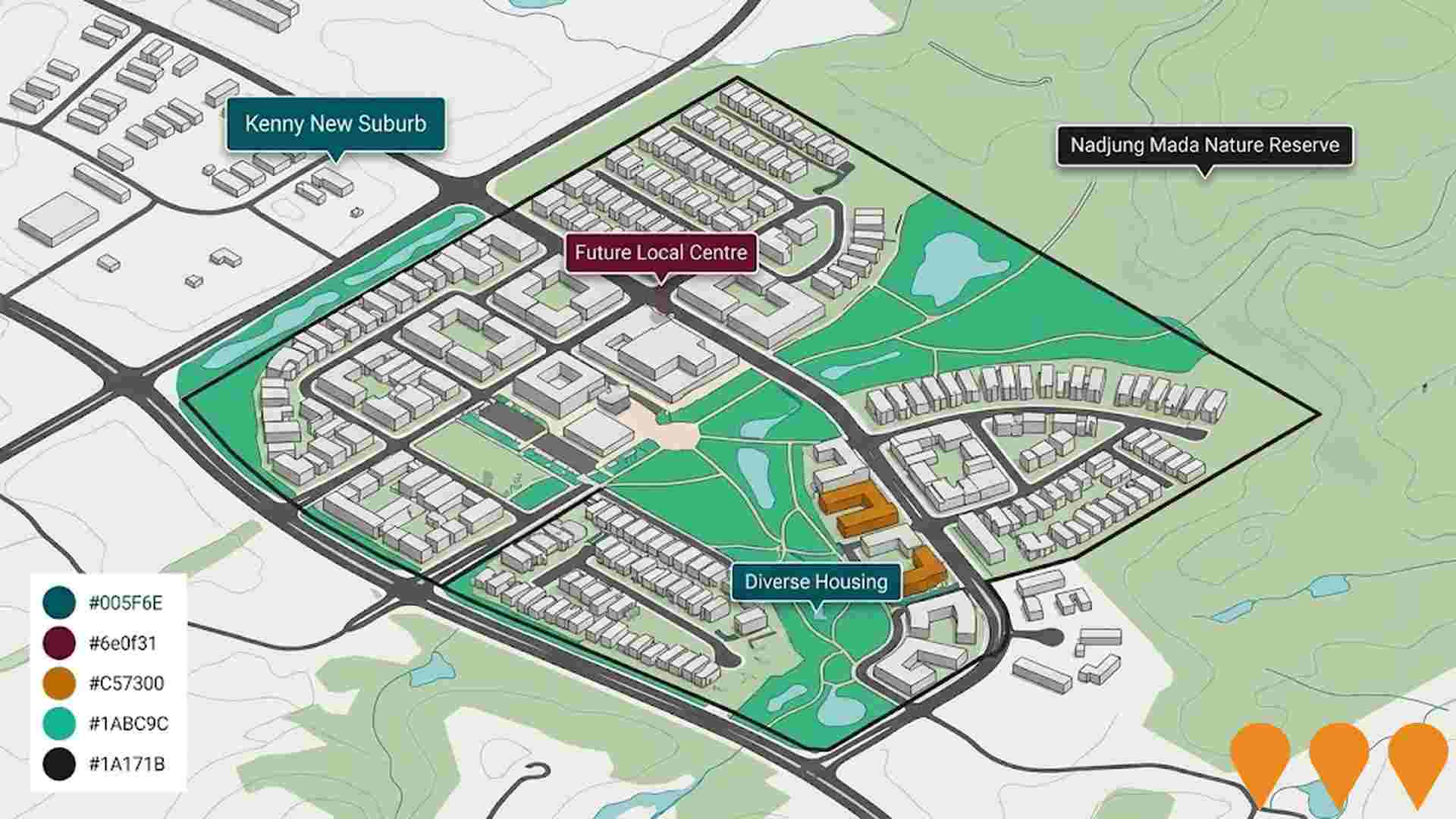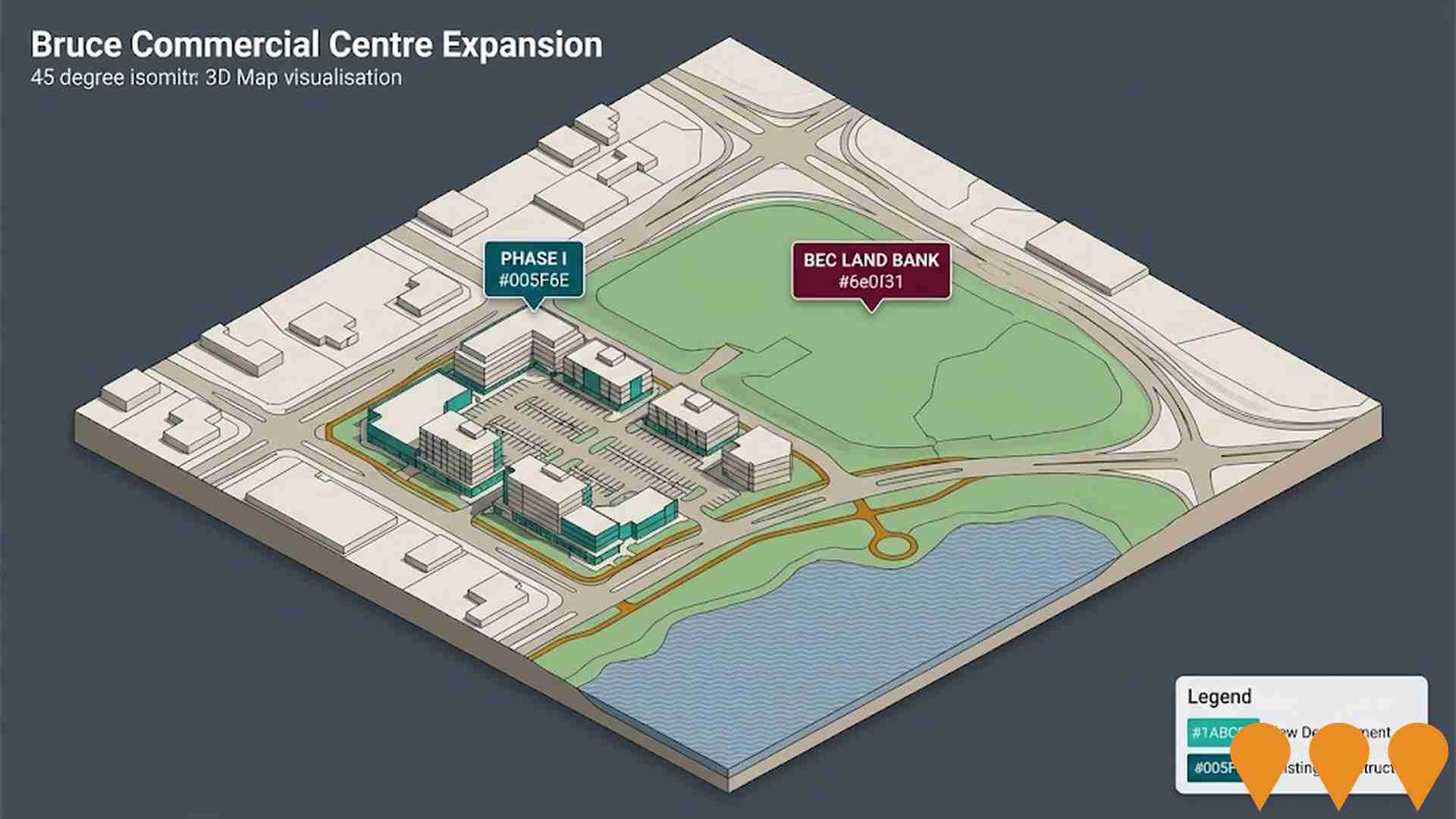Chart Color Schemes
est. as @ -- *
ABS ERP | -- people | --
2021 Census | -- people
Sales Activity
Curious about local property values? Filter the chart to assess the volume and appreciation (including resales) trends and regional comparisons, or scroll to the map below view this information at an individual property level.
Find a Recent Sale
Sales Detail
Population
Lawson lies within the top quartile of areas nationally for population growth performance according to AreaSearch analysis of recent, and medium to long-term trends
Lawson's population, as per AreaSearch's analysis, stood at 2,872 as of August 2025. This figure reflects an increase of 133 people since the 2021 Census, which reported a population of 2,739. The growth is inferred from ABS' estimated resident population of 2,872 in June 2024 and address validation since the Census date. This results in a density ratio of 932 persons per square kilometer, comparable to averages seen across other locations assessed by AreaSearch. Lawson's 4.9% growth since the 2021 census exceeded the SA3 area's 2.4%, positioning it as a regional growth leader. Natural growth contributed approximately 65.2% of overall population gains during recent periods.
AreaSearch adopts ABS/Geoscience Australia projections for each SA2 area, released in 2024 with 2022 as the base year. For areas not covered by this data and years post-2032, age group growth rates from the ACT Government's SA2 area projections are adopted, using 2022 as a base. Future population trends indicate a decline of 287 persons by 2041 according to these projections. However, specific age cohorts are expected to grow, notably the 45 to 54 age group, projected to increase by 70 people.
Frequently Asked Questions - Population
Development
Residential development activity is lower than average in Lawson according to AreaSearch's national comparison of local real estate markets
Lawson has averaged approximately one new dwelling approval annually over the past five financial years, totalling six homes. As of FY26, zero approvals have been recorded. Historically, between FY21 and FY25, an average of 91.2 new residents arrived per year for each dwelling constructed. This indicates significant demand exceeding supply, which typically drives price growth and increased buyer competition.
In the current financial year, $59,000 in commercial development approvals have been recorded, reflecting Lawson's residential nature. Compared to the Australian Capital Territory, Lawson has notably lower building activity, with 91% below the regional average per person. This scarcity of new dwellings often strengthens demand and prices for existing properties.
Nationally, Lawson's activity is also below average, suggesting maturity and potential planning constraints. Given stable or declining population forecasts, Lawson may experience less housing pressure in the future, creating more favourable conditions for buyers.
Frequently Asked Questions - Development
Infrastructure
Lawson has emerging levels of nearby infrastructure activity, ranking in the 25thth percentile nationally
Infrastructure changes significantly influence an area's performance. AreaSearch has identified 19 projects likely impacting the area. Notable projects include Mona Tait Gardens & Bullecourt Retirement Village Expansion, AIS Podium Project, CIT Yurauna Building, and Onderra. The following list details those most relevant.
Professional plan users can use the search below to filter and access additional projects.
INFRASTRUCTURE SEARCH
 Denotes AI-based impression for illustrative purposes only, not to be taken as definitive under any circumstances. Please follow links and conduct other investigations from the project's source for actual imagery. Developers and project owners wishing us to use original imagery please Contact Us and we will do so.
Denotes AI-based impression for illustrative purposes only, not to be taken as definitive under any circumstances. Please follow links and conduct other investigations from the project's source for actual imagery. Developers and project owners wishing us to use original imagery please Contact Us and we will do so.
Frequently Asked Questions - Infrastructure
Canberra Light Rail Stage 3: Belconnen to City (Bruce Alignment)
Planning and feasibility analysis for the future Stage 3 of the Canberra Light Rail network, connecting Belconnen Town Centre to the City via Bruce. The proposed corridor serves major precincts including the University of Canberra, CIT Bruce, North Canberra Hospital, and GIO Stadium. The project follows the Belconnen Transitway alignment and aims to provide high-capacity public transport to the north-west.

AIS Podium Project
Redevelopment of the Australian Institute of Sport campus in Bruce delivering a new High Performance Training and Testing Centre, a multi-sport indoor dome, and fully accessible athlete accommodation (approximately 200 beds). Construction commenced in October 2025 following Parliamentary approval.
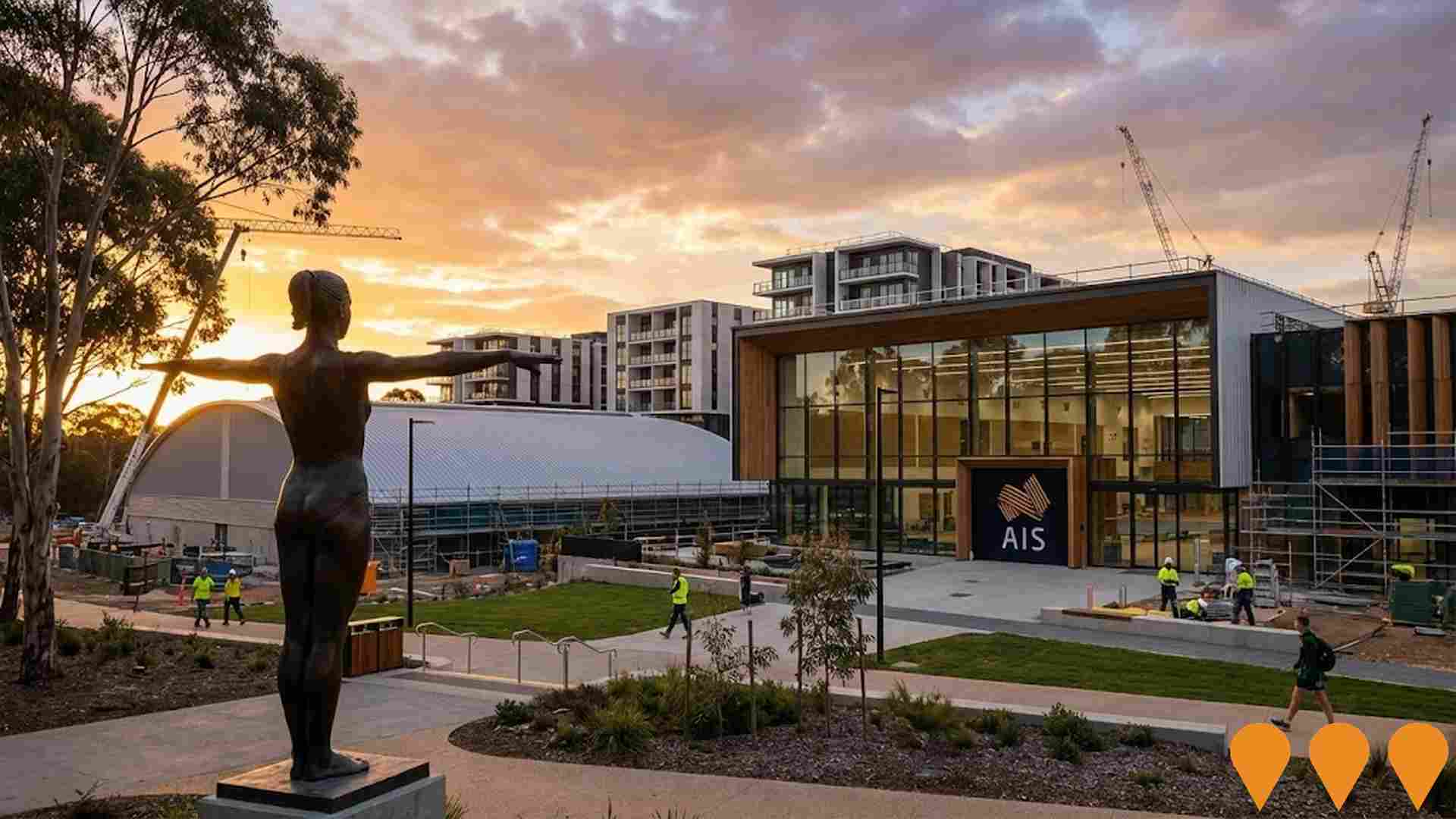
Onderra
Onderra is a large-scale sustainable masterplanned community by Peet Limited on the University of Canberra campus in Bruce, ACT. The 15-hectare precinct will deliver approximately 1,600 high-quality terraces, townhouses and apartments with 7-8 star energy ratings, extensive tree retention, solar-passive design, rainwater harvesting, EV charging and direct access to Lake Ginninderra and 22 hectares of connected parks and open space.

Bruce Sports, Health and Education Precinct
Integrated precinct development combining sports, health, and education facilities in Bruce. The project includes new sports facilities, health services, educational infrastructure, and supporting commercial development to create a major regional hub.
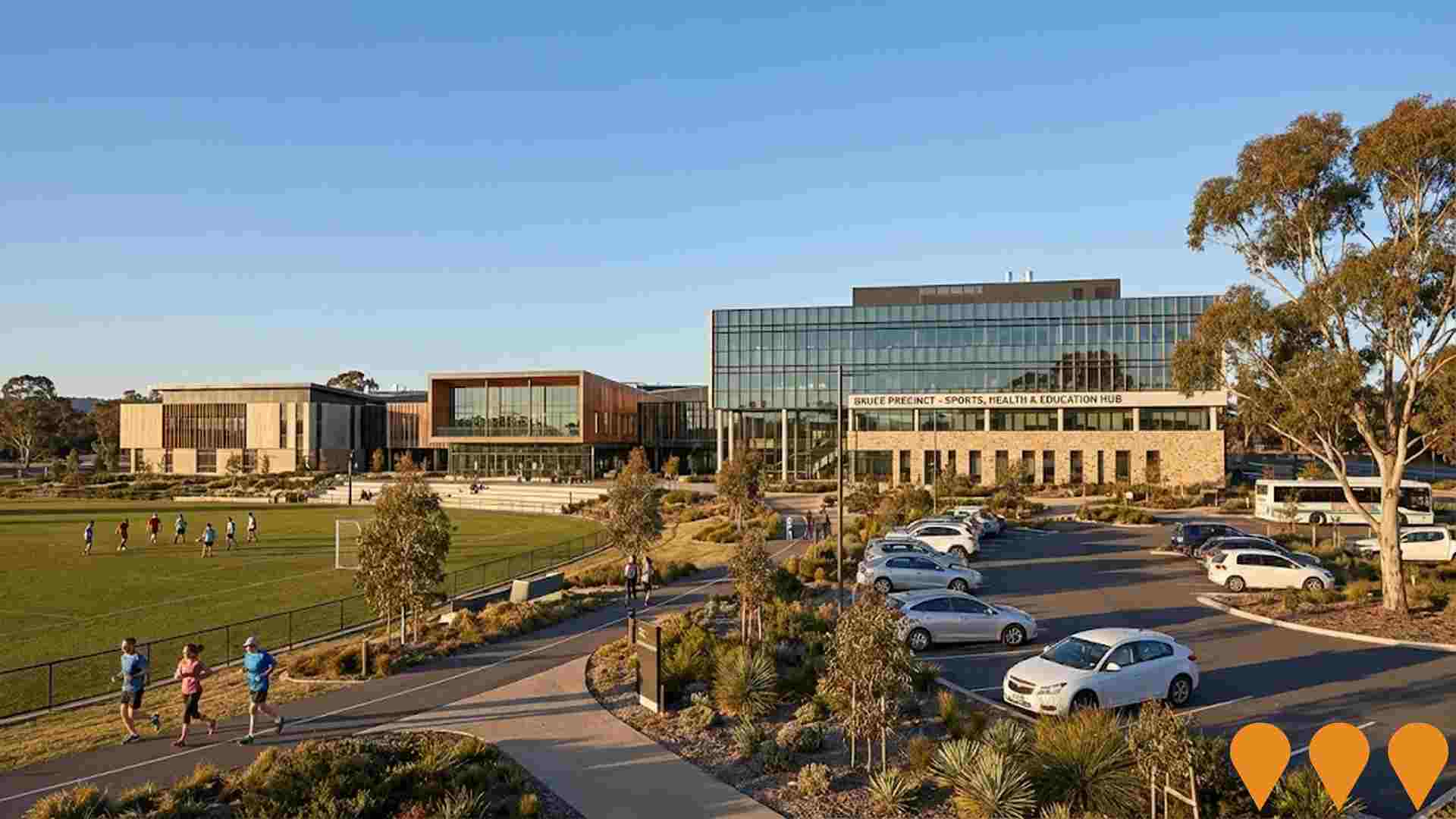
Kaleen Local Centre Enhancements
Potential future upgrade and modest expansion of Kaleen local shops (Kaleen Plaza) including improved access, parking, landscaping and retail floorspace. As of December 2025 no Development Application has been lodged for expansion of the plaza itself. Nearby public realm upgrades at Gwydir Square (South Kaleen) were completed in 2022, and a separate mixed-use DA at the former Eastlake Football Club site (16 Georgina Crescent) remains under assessment. This record tracks possible future plaza enhancements subject to lessee or ACT Government initiation.

University of Canberra Campus Master Plan
20-year campus redevelopment strategy for UC's Bruce campus. Priority projects include a Sports Hub, Health Neighbourhood, Aged Care and Retirement Village, a renewed Library, University Park and a Catalyst Building, alongside new academic, research and student living precincts.
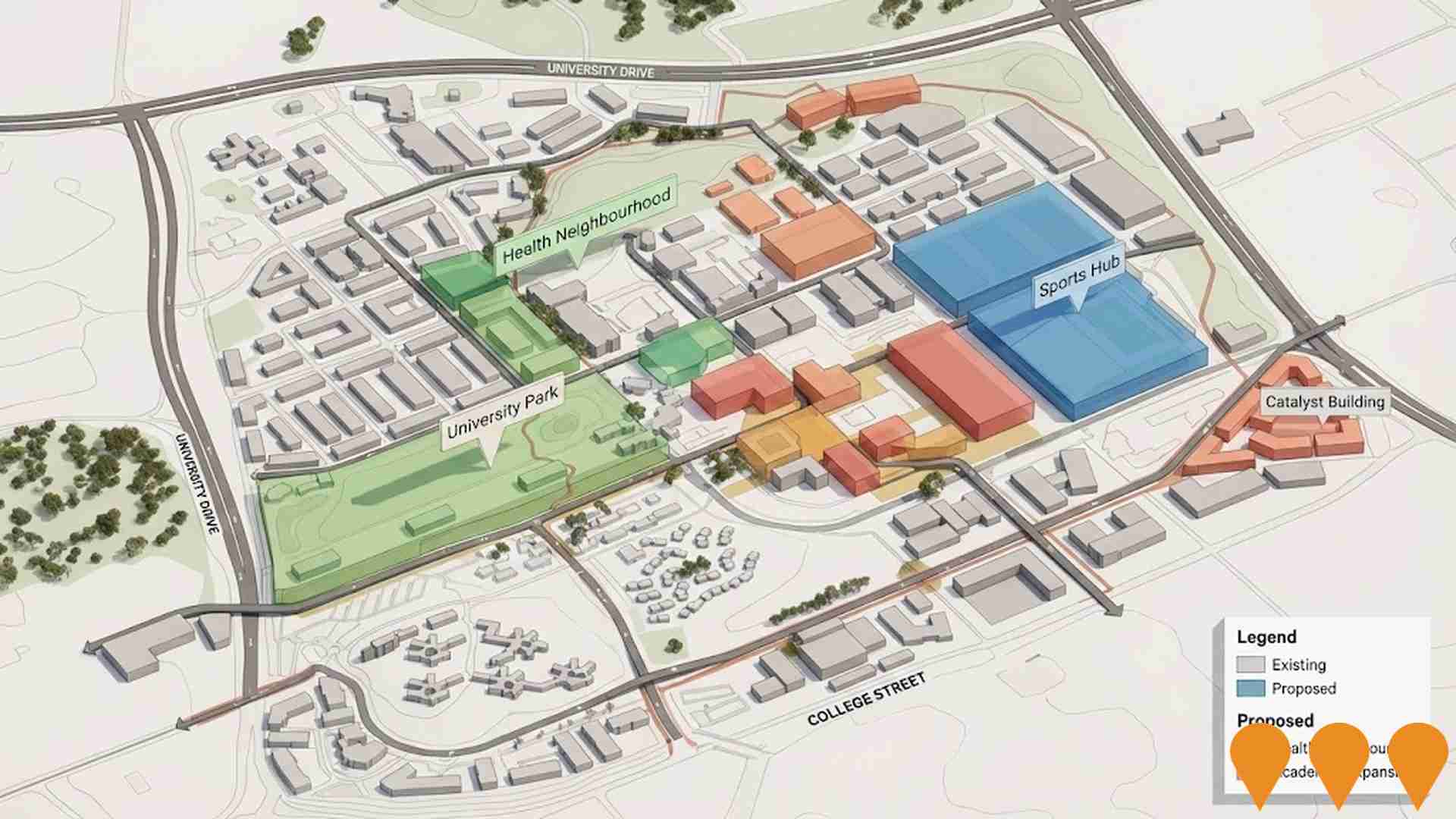
Kaleen Community Hub & Mixed-Use Precinct
Proposed mixed-use community hub at the current Kaleen shops site including new retail, medical centre, childcare, community facilities and medium-density residential apartments as part of the ACT Government's local centre renewal program.

Bruce Innovation District
Proposed innovation district in Bruce to attract technology companies, research organizations, and startups. The district would provide modern office spaces, research facilities, and collaboration hubs to foster innovation and economic development.
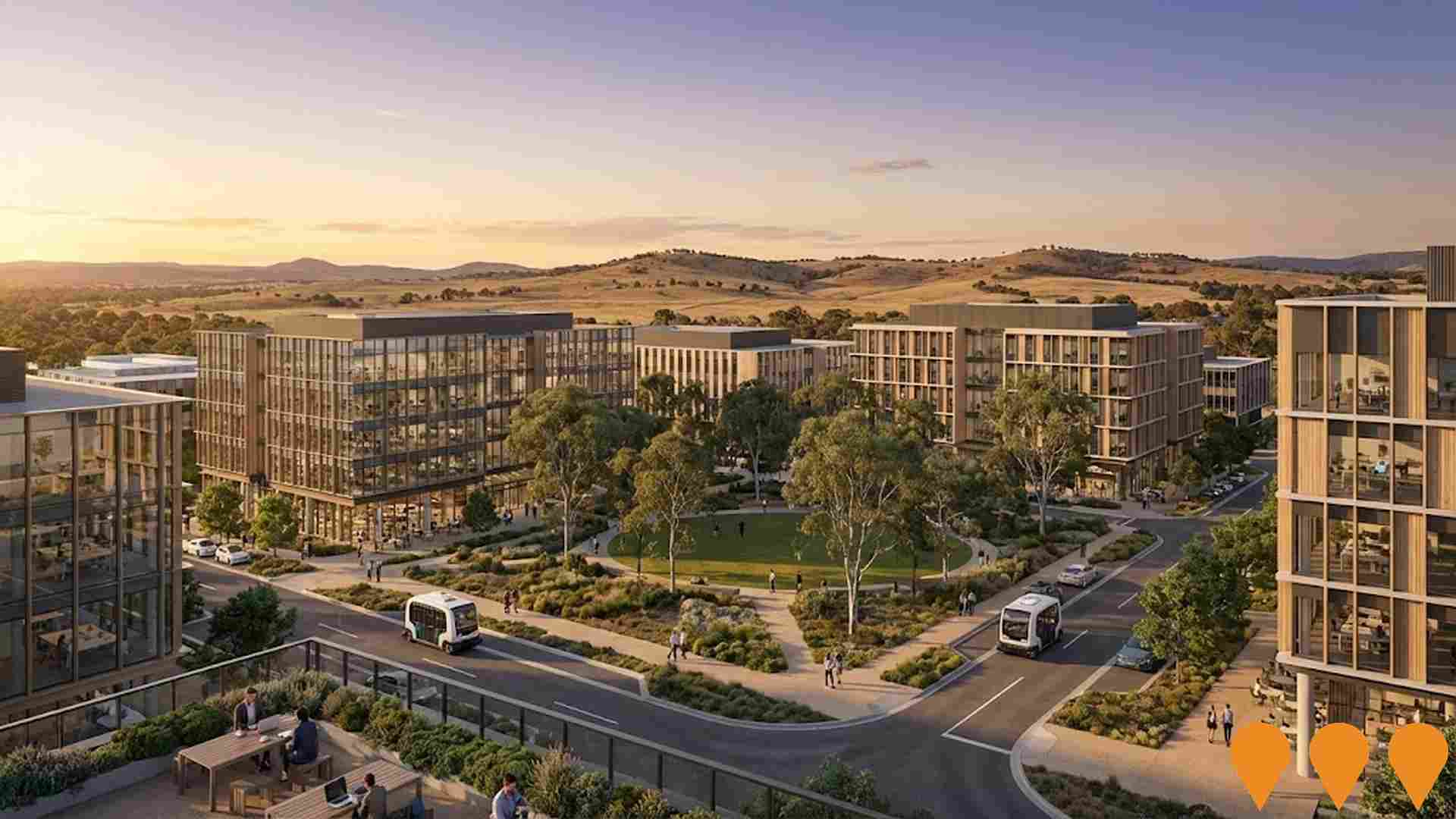
Employment
Employment conditions in Lawson rank among the top 10% of areas assessed nationally
Lawson's workforce is highly educated with strong professional services representation. Its unemployment rate was 1.2% in the past year, with an estimated employment growth of 1.3%.
As of June 2025, 2,179 residents are employed, with an unemployment rate of 2.2%, below the Australian Capital Territory's (ACT) rate of 3.4%. Workforce participation is high at 81.3% compared to ACT's 69.6%. Dominant employment sectors include public administration & safety, health care & social assistance, and professional & technical services. Lawson has a notable concentration in accommodation & food services, with employment levels at 1.5 times the regional average.
However, public administration & safety is under-represented, comprising only 20.9% of Lawson's workforce compared to ACT's 30.4%. Local employment opportunities appear limited based on Census working population vs resident population data. Between June 2024 and June 2025, employment increased by 1.3%, labour force by 1.6%, raising the unemployment rate by 0.2 percentage points. In contrast, ACT recorded employment growth of 1.9% with a decrease in unemployment by 0.3 percentage points. Jobs and Skills Australia's national employment forecasts from May 2025 project national employment expansion by 6.6% over five years and 13.7% over ten years. Applying these projections to Lawson's employment mix suggests local growth of approximately 6.8% over five years and 13.8% over ten years, though these are simple extrapolations for illustrative purposes only.
Frequently Asked Questions - Employment
Income
The economic profile demonstrates exceptional strength, placing the area among the top 10% nationally based on comprehensive AreaSearch income analysis
AreaSearch's latest postcode level ATO data for financial year 2022 shows Lawson's median income among taxpayers is $66,556, with an average of $80,376. Nationally, these figures are extremely high compared to the Australian Capital Territory's median of $68,678 and average of $83,634. As of September 2025, estimates based on Wage Price Index growth of 13.6% would be approximately $75,608 (median) and $91,307 (average). According to the 2021 Census figures, Lawson's household, family, and personal incomes rank highly nationally, between the 90th and 91st percentiles. In terms of income distribution, 40.7% of residents (1,168 people) fall within the $1,500 - $2,999 bracket, mirroring the broader area where 34.3% occupy this bracket. Economic strength is evident with 40.3% of households achieving high weekly earnings exceeding $3,000, supporting elevated consumer spending. High housing costs consume 18.6% of income, but strong earnings place disposable income at the 87th percentile nationally. The area's SEIFA income ranking places it in the 10th decile.
Frequently Asked Questions - Income
Housing
Lawson displays a diverse mix of dwelling types, with a higher proportion of rental properties than the broader region
Lawson's dwelling structure, as per the latest Census, consisted of 19.7% houses and 80.3% other dwellings (semi-detached, apartments, 'other' dwellings), compared to Australian Capital Territory's 69.4% houses and 30.5% other dwellings. Home ownership in Lawson was at 8.1%, with mortgaged dwellings at 45.8% and rented ones at 46.0%. The median monthly mortgage repayment in Lawson was $2,000, aligning with the Australian Capital Territory average, while median weekly rent was $548, compared to Australian Capital Territory's $2,000 and $430 respectively. Nationally, Lawson's mortgage repayments were higher than the Australian average of $1,863, and rents were substantially above the national figure of $375.
Frequently Asked Questions - Housing
Household Composition
Lawson features high concentrations of group households, with a higher-than-average median household size
Family households constitute 62.4% of all households, including 21.5% couples with children, 31.5% couples without children, and 5.9% single parent families. Non-family households comprise the remaining 37.6%, with lone person households at 19.6% and group households making up 17.5%. The median household size is 2.6 people, which is larger than the Australian Capital Territory average of 2.5.
Frequently Asked Questions - Households
Local Schools & Education
The educational profile of Lawson exceeds national averages, with above-average qualification levels and academic performance metrics
Lawson has a notably high level of educational attainment among its residents aged 15 and above. Specifically, 62.7% hold university qualifications, which is significantly higher than the national average of 30.4% and the SA3 area average of 43.8%. This indicates a substantial educational advantage for Lawson. Bachelor degrees are the most common at 35.5%, followed by postgraduate qualifications at 23.1% and graduate diplomas at 4.1%.
Vocational pathways account for 16.6% of qualifications, with advanced diplomas making up 7.5% and certificates 9.1%. Educational participation is high in Lawson, with 38.4% of residents currently enrolled in formal education. This includes 20.1% in tertiary education, 5.6% in primary education, and 3.6% pursuing secondary education. However, educational facilities appear to be located outside Lawson's immediate catchment boundaries, requiring families to access schools in neighboring areas for their educational needs.
Frequently Asked Questions - Education
Schools Detail
Nearby Services & Amenities
Transport
Transport servicing is good compared to other areas nationally based on assessment of service frequency, route connectivity and accessibility
Lawson has 10 active public transport stops operating. These are a mix of bus stops serviced by 5 different routes. Together, these routes provide 1233 weekly passenger trips.
The average distance from residents to the nearest stop is 168 meters. On average, there are 176 trips per day across all routes, which equates to about 123 weekly trips per individual stop.
Frequently Asked Questions - Transport
Transport Stops Detail
Health
Lawson's residents boast exceedingly positive health performance metrics with very low prevalence of common health conditions across all age groups
Lawson's health outcomes data shows excellent results across all age groups, with a very low prevalence of common health conditions. Approximately 60% (1,717 people) have private health cover, compared to 57.1% in Australian Capital Territory.
Mental health issues and asthma are the most prevalent medical conditions, affecting 6.7% and 6.5% of residents respectively. A total of 84.0% of residents report being completely free from medical ailments, compared to 68.1% across Australian Capital Territory. Lawson has a lower percentage of seniors aged 65 and over at 3.0% (87 people), compared to the 15.3% in Australian Capital Territory. Health outcomes among seniors are notably strong and align with the overall population's health profile.
Frequently Asked Questions - Health
Cultural Diversity
Lawson is among the most culturally diverse areas in the country based on AreaSearch assessment of a range of language and cultural background related metrics
Lawson has one of the most culturally diverse populations in Australia, with 54.0% speaking a language other than English at home and 53.0% born overseas. Christianity is the predominant religion in Lawson, comprising 25.4% of its population. However, Hinduism is notably overrepresented, making up 11.3%, compared to the Australian Capital Territory average of 4.0%.
In terms of ancestry, the most represented groups are Other at 18.6%, Chinese at 17.6%, and English at 15.2%. These figures differ significantly from regional averages: Other is substantially higher (18.6% vs 12.0%), Chinese is notably higher (17.6% vs 4.2%), and English is notably lower (15.2% vs 23.7%). Additionally, certain ethnic groups are overrepresented in Lawson compared to regional averages: Korean at 1.6% (vs 0.4%), Indian at 7.7% (vs 2.5%), and Vietnamese at 2.8% (vs 1.2%).
Frequently Asked Questions - Diversity
Age
Lawson hosts a very young demographic, ranking in the bottom 10% of areas nationwide
Lawson's median age is 29 years, which is notably lower than the Australian Capital Territory average of 35 years and substantially lower than Australia's median age of 38 years. Compared to the Australian Capital Territory, Lawson has a higher concentration of residents aged 25-34 (36.7%) but fewer residents aged 65-74 (1.5%). This concentration of residents aged 25-34 is well above the national average of 14.5%. Following the Census conducted on 28 August 2021, residents in Lawson have aged by an average of 1 year, with the median age rising from 28 years to 29 years. Specifically, the proportion of residents aged 35-44 has grown from 16% to 19.1%, while those aged 45-54 increased from 6.4% to 8.6%. Conversely, the proportion of residents aged 15-24 has declined from 21% to 16.1%, and those aged 0-4 have dropped from 5.8% to 4.6%. Demographic modeling suggests that Lawson's age profile will evolve significantly by 2041. The number of residents aged 85 and above is projected to grow exceptionally, increasing by 59 people (a 596% rise) from 10 to 70. Notably, the combined age groups of 65+ will account for 51% of total population growth, reflecting Lawson's aging demographic profile. Conversely, both age groups of 65-74 and 0-4 are expected to see reduced numbers.
